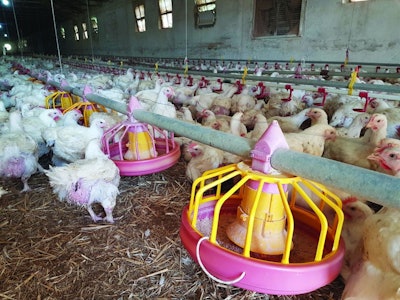
Within poultry processing operations, there are numerous areas that need to be monitored to ensure quality, safety and yield. However, among these, there are some key activities that need particular attention and that all employees should understand if broilers are to processed well and for the plant to meet its targets.
Feed withdrawal
Feed withdrawal should start 8-12 hours prior to slaughter.
Under normal conditions, it will take 4-4.5 hours from ingestion for feed to pass through a broiler and be evacuated. There are, however, a number of situations that can alter this.
The time it takes for feed to pass through the broiler is an important consideration as it will dictate when harvesting should take place.
Birds tend to eat more in the evening. They will also consume more when the ambient temperature falls below 15 C or exceeds 32 C. This may mean that that harvesting should be delayed by at least three hours.
Overly long and overly short feed withdrawal periods can affect quality and yield.
As time passes, birds will dehydrate and this will become problematic when the withdrawal period exceeds 12 hours and yield is reduced.
A feed withdrawal period that is too short will have a different impact. During bleed, for example, given that birds do not have a diaphragm, any remaining feed will put pressure on the trachea, making breathing difficult.
Consequently, birds will flap their wings and writhe in the shackles which can cause bruising to the wings and bleeds in the breast, along with breaks to the thorax bones.
Should this be observed in the plant, broilers’ upper breast area should be checked when they exit the last plucking machine to ensure that their crops do not still contain feed. It is important that this is ascertained and the assumption not made that the stunning voltage is insufficient and so unnecessarily increased.
Bleed
It is impossible to fully bleed a broiler due to the onset of rigor mortis. In most plants, a bleed of 45-50% is achieved.
Due to vasodilation, bleed times are shorter in hot climates and when a plant is located below 800 meters above sea level, and range from 2 minutes and 45 seconds to 3 minutes and 30 seconds.
Wing and tail feather difficulties
Wing and tail feathers can be difficult to remove during plucking as they spring directly from muscle, but there are other factors that can make their removal difficult.
At stunning, for example, excess voltage leads to greater muscular contraction. With the onset of rigor mortis, these feathers also become harder to remove.
Poor scalding will also contribute to making wing and tail feather removal more difficult. Should carcasses not be fully submerged in the scalder, the tail feathers, and some on the wings, will remain above the water line. Follicles will not fully dilate while the protein that holds the feathers in place will not fully denature.
Scalding results in an increase in the carcass’ surface temperature. However, if heat is lost while carcasses are moved from the scalder to the plucking machines, the latter may need to be closed a little more to increase the pressure applied to the carcass.
Additional pressure, however, can lead to problems including skin tears to the breast and thighs, wing dislocation, and the evacuation of remaining fecal material which can cause cross-contamination problems.
These issues can be avoided if heat is conserved, and this can be achieved through the construction of a tunnel that runs from the scalders to the plucking machines. The latter must also be covered to conserve heat.
Another way to aid the removal of difficult feathers is to apply water at 34-38 C to the plucking fingers, which helps prevent heat loss.
Following the above will help to ensure feather removal using minimal pressure, but it is worth remembering that the plucking machines should slope slightly toward the exit, which will increase the contact time of the wings that are plucked by the lower fingers.
Where to measure yield?
There a number of points at which yield can be measured. It can be measured at the entrance to the scalder, for example. Selected birds that have been weighed live prior to hanging on the slaughter line can be removed from the shackles prior to entering the scalder. The difference in weight should be no more than 3% and so the yield should be 97% at this point.
Yield can also be measured on exiting the last plucking machine. In the case of a Cobb 500 birds, for example, feathers account for 3.7% of the bird’s total weight, so at this point the yield should be 93.3%.
Yield can also be assessed prior to entering the pre-chiller or at the start of air chilling, at which point carcass weight should be either 72% or 74% of the weight of the live bird.
It is worth remembering that these percentages can vary slightly depending on factors such as whether legs are cut above or below the joint, and how much neck is left on the carcass.

Well-designed plants can help to prevent bottlenecks from occurring. (Canerozkan | iStock.com)
The issue of bottlenecks
Bottlenecks tend to occur in two areas in particular: at transfer between the slaughter conveyor and the evisceration conveyor, and at the exit from the water chiller.
In the case of the former, if transfer is performed manually, birds can build up on the table where they are placed after being taken down from the first conveyor and before being hung on the second. This buildup occurs as a result of poor ergonomics.
Depending the number of carcasses that accumulate, fecal contamination may occur and, if they remain on the table for too long, bacterial growth will start.
When birds exit the water chiller, bottlenecks may also occur and this can lead to a loss of water, rising carcass temperatures, and the need to bring in more workers.

















